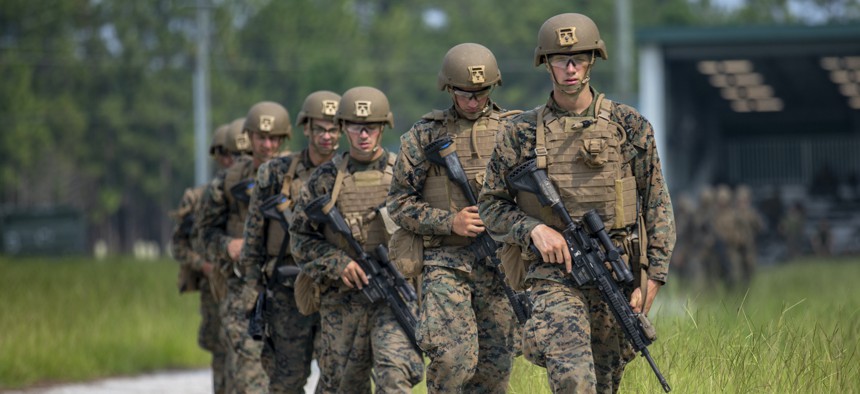
Students with the School of Infantry-East conduct a patrol during the Infantry Marine Course (IMC) on Marine Corps Base Camp Lejeune, North Carolina, July 22, 2021. U.S. Marine Corps / Lance Cpl. Isaiah Gomez
Marine Infantry Battalion Experiment Needs More Time, General Says
‘I would expect that this will continue to be a learning process over the next couple of years,’ Maj. Gen. Watson said.
After two years of experimentation meant to shape future Marine infantry battalions, officials are asking the commandant for more time.
“The experimentation we've conducted to date has been essential, but not sufficient,” Maj. Gen. Benjamin Watson, the commanding general of the Marine Corps Warfighting Laboratory, told reporters last week, ahead of the annual Force Design 2030 update released Monday.
Marine Corps Commandant David Berger’s initial Force Design 2030 plan called for the Infantry Battalion Experiment to test a concept that involves smaller units trained on multiple weapons. Three Marine battalions were chosen to test versions of the plan. One battalion—1st Battalion, 3rd Marines—is organized exactly to the document’s proposed design, with 735 Marines instead of 896, and a mix of newer weapons and some that are still being developed. First Battalion, 1st Marines, is similar to current infantry battalions with some small changes, and 1st Battalion, 2nd Marines, falls in between.
The newest annual update on Force Design 2030 says the experimentation so far has found that infantry battalions of 800 to 835 people are “optimal.” Watson said they tried to learn what was possible and reasonable to ask of individual Marines in terms of mastering different skills and weapons and operating as a distributed force. The higher end strength will be recommended to the commandant.
The recommendations to Berger based on the experiment so far are still “pre-decisional” and at the three-star level, Watson said, with the final decision expected this summer. The Warfighting Lab is taking an “intermediate step” with recommendations based on what they have learned so far, he said, but there remain several things that need more testing.
“So we're recommending a second phase of infantry battalion experimentation for [fiscal year 2023] into [fiscal year 2024] to continue to learn and ratchet down on the questions we still have unresolved. And so, I would expect that this will continue to be a learning process over the next couple of years,” Watson said.
One of the “directed actions” for infantry battalions in the annual Force Design update is to “experiment with the hunter-killer platoon concept as part of the continuing [Infantry Battalion Experiment] campaign and provide findings and recommendations at the Executive Off-Site,” a meeting of senior Marine Corps leaders.
Hunter-killer operations are going after enemy forces “within their own places of safety, disrupt their operations and sustainment, and neutralize or destroy them,” according to the Marine Corps’ document on ground reconnaissance operations.


